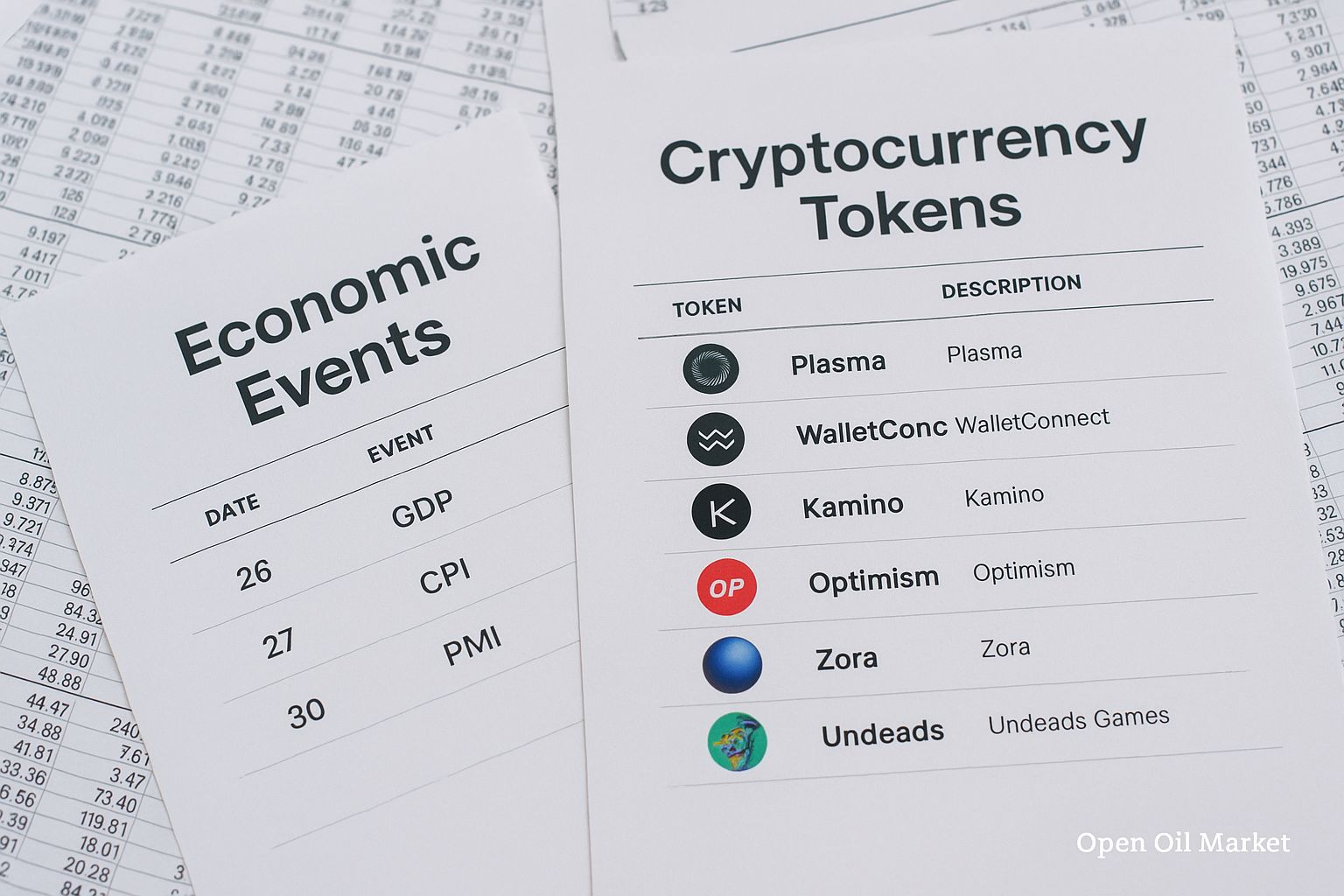
Latest Cryptocurrency Updates as of September 19, 2025: Bitcoin Approaches Psychological Threshold of $120 Thousand, Altcoins Continue Rally Amid Influx of Institutional Capital and Favorable Regulations. Analysis of Top-10 Cryptocurrencies with Current Rates and Market Capitalization.
As the workweek comes to a close, the cryptocurrency market maintains a confident upward trend. Bitcoin has closely approached the historically significant mark of $120,000, showcasing one of the best performances for September in recent years. Major altcoins are also on the rise, with many of them achieving double-digit percentage price increases in recent days. Investors are optimistic following the recent decrease in the U.S. Federal Reserve's interest rate, anticipating an influx of additional liquidity into the markets. Further optimism stems from record institutional capital inflows through exchange-traded funds, technological integration of stablecoins by corporations, and signs of regulatory easing.
Bitcoin Storms to New Heights
Bitcoin (BTC) continues to consolidate at record high levels around $118,000–119,000, just shy of the psychological threshold of $120,000. Since the beginning of September, the leading cryptocurrency has appreciated by approximately 8%, contrasting with the typically calmer dynamics observed during this month. The current price more than doubles the peak of the previous cycle in 2021, with BTC's market capitalization now exceeding $2.3 trillion, making it comparable to the largest global corporations in valuation. Despite some early investors taking partial profits at these levels, interest from major players remains strong. For instance, MicroStrategy has once again increased its crypto portfolio, bringing its holdings to nearly 639,000 BTC. The sustained demand from institutional investors even at near-peak prices underscores Bitcoin's role as a long-term asset. Since the beginning of the year, BTC's price has risen by more than 20%, and many analysts expect a traditionally strong fourth quarter. The market is now closely watching whether Bitcoin can break through the crucial $120,000 milestone in the coming days and pave the way for new highs.
Ethereum Approaches Record Level
Following Bitcoin's lead, Ethereum (ETH)—the second largest cryptocurrency by market capitalization—is also exhibiting strong growth. Ethereum's price hovers around $4,500, less than 10% below its all-time high (~$4,950 reached at the end of August). After a summer correction, ETH is beginning to rise again: technical indicators are signaling a stable upward trend. Large holders ("whales") continue to increase their positions, anticipating that Ethereum may grow at a faster pace than Bitcoin. The increasing institutional interest further boosts the ETH market. In the U.S., the first spot ETFs for Ethereum launched in recent months, enabling large investors to actively invest in the asset. Industry data indicates that the total assets under management of Ether ETFs have surpassed $30 billion, with daily inflows to Ethereum funds sometimes reaching $400 million. The reduction in ETH supply on exchanges due to such investments intensifies upward pressure on prices. Ethereum's close proximity to its all-time high is attracting more attention: breaking above the psychological mark of $5,000 could trigger a new wave of growth for this smart contract platform.
Altcoins and "Altseason" Gain Momentum
A widespread growth has enveloped nearly the entire sector of major alternative cryptocurrencies, indicating a continuing "altseason." Bitcoin's market share has dropped to approximately 56–57%, having exceeded 65% earlier this year. Investors are actively investing in altcoins in search of higher returns. Many of the top altcoins are breaking multi-year highs or are nearly there:
- Binance Coin (BNB) – has appreciated by more than 15% in recent weeks, surpassing $960 for the first time. Currently, BNB is trading around $970 with a market capitalization of approximately $150 billion. This growth is linked to positive news surrounding the Binance exchange—investors anticipate a reduction in regulatory risks and note the potential return of Changpeng Zhao to active management of the company.
- XRP (Ripple) – has strengthened to around ~$3.0, levels not seen since early 2018. XRP's market capitalization has reached approximately $180 billion, propelling the token into the top three market leaders. XRP's growth is supported by overall market revival and legal clarity: following Ripple's victory in the SEC lawsuit in 2023, investor confidence in the token has significantly increased, and banks are increasingly testing the use of RippleNet for international payments.
- Solana (SOL) – has risen to ~$240, nearly returning to its record levels from late 2021. SOL's market capitalization exceeds $130 billion, placing it among the top five crypto assets. Investor confidence in Solana has been restored following the resolution of previous technical issues: the network is operating reliably in 2025, and major investment funds (e.g., Pantera Capital) are acquiring SOL, expecting further growth of the Solana ecosystem.
- TRON (TRX) – has risen to ~$0.35, setting a new historical high. The project's market capitalization has approached $30 billion. The TRON network is widely used for issuing stablecoins (a significant portion of USDT circulates in the Tron network) and for low-cost cross-border transfers, especially popular in Asia. TRX's growth reflects the high demand for these services and an influx of users.
- Cardano (ADA) – has exceeded $0.90 (market cap around $30 billion), gradually restoring lost positions. Over the past few weeks, ADA has increased by more than 10%, signaling a resurgence of interest in the Cardano platform. As the implementation of phased technical updates progresses, community confidence in the project's long-term outlook is strengthening.
Additionally, a resurgence of more speculative crypto assets is observed. For instance, meme tokens are demonstrating increased volatility during the general rally: Dogecoin (DOGE), the most recognized meme coin, has risen by approximately 20% in the past week and is currently around $0.27. Although there was a slight price pullback for DOGE and SHIB today due to profit-taking, retail investor interest in them remains high. Notably, the meme cryptocurrency sector has even introduced its first exchange-traded fund (ETF) targeting a basket of such tokens, bringing these joke coins closer to traditional finance. Overall, the broad-based rally among altcoins underscores an increased appetite for risk and diversification beyond Bitcoin by investors.
Institutional Investment via Crypto Funds Hits Record Highs
One of the key drivers of the current rally is a substantial influx of institutional capital into digital assets. Recent data reveals record activity in the cryptocurrency-linked exchange-traded funds (ETFs) market. In the first half of September alone, the total net inflow into spot Bitcoin ETFs exceeded $3 billion. Major funds from renowned managers—such as BlackRock (IBIT) and Fidelity (FBTC)—are attracting hundreds of millions of dollars daily. The total assets under management for all Bitcoin ETFs are currently valued at more than $150 billion, equivalent to approximately 6–7% of Bitcoin's total market capitalization. Just a couple of years ago, such levels of institutional involvement seemed unimaginable, but by 2025, it has become a reality, maintaining steady demand for the number one cryptocurrency.
Funds focused on Ethereum are also keeping pace: since the launch of the world's first spot Ether ETFs last summer, investors have been actively reallocating part of their capital towards Ethereum. Analysts estimate that on certain days, inflows to ETH funds exceed $400 million, cumulatively amounting to billions of dollars since the beginning of the year. The rise in institutional engagement strengthens the legitimacy of the crypto market and helps reduce volatility, as a significant portion of coins concentrates in funds and is removed from circulation. Furthermore, major banks and hedge funds are also exhibiting heightened interest in the sector: an increasing number of traditional financial institutions are offering their clients cryptocurrency-related products. In the context of declining interest rates and limited yields on classical assets, investment firms are viewing Bitcoin and Ethereum as ways to enhance overall portfolio returns while simultaneously diversifying risks. The institutional foundation of the market has noticeably strengthened in 2025, creating more stable conditions for the industry's further development.
Technological Integration: Stablecoins and Fintech
This week's news also includes developments in the realm of blockchain technological integration. Major corporations continue to explore crypto technologies, particularly in the area of stablecoins. For instance, Google recently announced the launch of an experimental open payment protocol for interaction between AI agents, supporting transactions in stablecoins. The project involved specialists from Coinbase, the Ethereum Foundation, as well as more than 60 other organizations (including American Express and Etsy). The new protocol will allow software "agents"—for example, a trading AI application and a virtual shopper—to conduct mutual settlements with one another automatically and securely. The system supports both traditional payment methods (bank cards) and stable cryptocurrencies pegged to the U.S. dollar.
The interest of tech giants in stablecoins is attributed to their potential to lower costs and expedite international payments. According to industry reports, several IT industry leaders (including Google, Apple, and social media platform X) are exploring the integration of stablecoins into their payment products in 2025. Additionally, financial companies are expanding their cryptocurrency services: for instance, PayPal this week launched a feature for cryptocurrency transfers (BTC, ETH, and their own stablecoin PYUSD) between users of its application, simplifying the use of digital currencies in everyday transactions. The stablecoin market is currently estimated at nearly $300 billion, with the flagship token USDT (Tether) having a market capitalization of around $170 billion, providing a significant portion of liquidity on crypto exchanges. The second most popular USD Coin (USDC), issued by the Centre consortium (Circle and Coinbase), has a market value of approximately $70 billion. The model of stablecoins presumes securing equivalent fiat reserves (primarily in U.S. government bonds), making them relatively reliable instruments for transactions. Experts forecast a tremendous growth for the stablecoin market in the coming years—especially as the U.S. administration has prioritized the development of digital dollar tokens in its financial policy. The active involvement of companies like Google and PayPal confirms the trend towards bridging traditional technologies and blockchain, broadening the scope of cryptocurrency applications beyond trading and investment.
Regulation: Easing Positions in the U.S., Collaboration in Europe, and Caution in Russia
The regulatory environment surrounding cryptocurrencies is gradually improving, positively impacting investor sentiment. In the United States, the news that the U.S. Department of Justice is poised to remove external oversight from the Binance exchange has been a positive development. This monitoring was established in 2023 as part of a global settlement (with a $4.3 billion fine) and involved independent oversight of Binance's anti-money laundering measures. The potential early termination of this oversight indicates the strengthening of the exchange's internal controls and a more lenient approach from regulators towards business, which investors view as a signal of normalization concerning one of the largest crypto companies.
Additional boosts to industry trust came from a recent action by Binance founder Changpeng Zhao (CZ): he updated his profile on social media platform X, removing the prefix "ex-" and reinstating his association with Binance. The community interpreted this as a hint at CZ's possible return to active involvement in the company's affairs, further reinforcing confidence in the platform's future. Overall, a trend toward integrating the crypto industry into legal frameworks is observable in the U.S. The Securities and Exchange Commission (SEC) has recently approved the launch of several spot ETFs for Bitcoin and Ethereum that previously seemed unlikely. There is also an increasing interaction between authorities and the industry: this week, representatives from the U.S. and the U.K. held talks on closer collaboration in cryptocurrency regulation, seeking to develop unified approaches to the oversight of digital assets.
In the European Union, a comprehensive regulation known as MiCA is coming into effect, establishing unified rules for the crypto industry across EU countries. Regulators from individual EU states are already calling for intensified market oversight under the new norms, particularly focusing on preventing the use of crypto assets to evade sanctions. The heightened attention of European authorities to the crypto market aims to enhance transparency and protect investors, potentially boosting trust in digital assets across the continent in the long run.
In Russia, regulators maintain a cautious stance, although they are also taking steps towards legalizing certain aspects of cryptocurrencies. The Central Bank of Russia recently stated its intention to finalize discussions with the Ministry of Finance regarding the regulation of investments in crypto assets by the end of the year. This could lead to clearer rules for qualified investors looking to invest in digital currencies. An experiment with the digital ruble has already been launched in Russia, and international transactions in cryptocurrencies are permitted in certain cases; however, stringent restrictions still exist for the widespread circulation of private crypto assets within the country. Nevertheless, the observed gradual formation of regulations in major jurisdictions (the U.S., EU, China, RF) minimizes legal risks for market participants. Collectively, the global regulatory landscape is becoming clearer and more favorable, promoting further institutionalization of the crypto industry.
Top 10 Most Popular Cryptocurrencies
- Bitcoin (BTC) – the first and largest cryptocurrency, often referred to as "digital gold." Price ~ $118,000; market capitalization around $2.35 trillion. Bitcoin serves as the main indicator of the cryptocurrency market's state, has a limited supply (21 million coins), and in 2025 reached an all-time high, solidifying its role as a reserve asset for institutional investors.
- Ethereum (ETH) – the second largest digital asset by market capitalization and the leading smart contract platform. Price ~ $4,500; capitalization around $560 billion. Ethereum underpins decentralized finance (DeFi), NFT ecosystems, and a multitude of blockchain applications. ETH is currently close to its all-time high, reflecting strong demand for Ethereum's network services.
- Tether (USDT) – the largest stable token (stablecoin), pegged to the U.S. dollar (1 USDT = $1.00). Issued by Tether and backed by fiat currency reserves; current market capitalization ~ $170 billion. USDT ensures high liquidity on cryptocurrency exchanges, serves as the primary means of transactions between cryptocurrencies, and is widely used by traders to hedge volatility.
- Binance Coin (BNB) – the native token of the largest cryptocurrency exchange Binance and its blockchain platform BNB Chain. Price ~ $970; capitalization around $150 billion. BNB is used for paying fees on the exchange and in smart contracts and applications across the Binance ecosystem. In 2025, BNB's price reached a historical high amid increased activity on the platform and expanded use cases for the coin.
- XRP (Ripple) – the token of the Ripple payment network designed for fast cross-border bank transfers. Price ~ $3.0; capitalization ~ $180 billion. XRP reached its highest values in recent years due to a positive outcome in legal disputes in the U.S. and increased adoption of Ripple's technology by banks in 2025. The token has re-entered the top three largest cryptocurrencies by market valuation.
- USD Coin (USDC) – the second most significant stablecoin issued by the Centre consortium (with participation from Circle and Coinbase). 1 USDC = $1.00, capitalization around $70 billion. USD Coin is fully backed by dollar reserves and considered one of the most reliable stablecoins due to auditor transparency and regulatory support. It is widely used in trading, payments, and the DeFi sectors.
- Solana (SOL) – a high-speed layer one blockchain platform competing with Ethereum. Price ~ $240; capitalization > $130 billion. Solana attracts decentralized application developers due to its high throughput and low fees. In 2025, SOL significantly rose in price, recovering from the decline in 2022, entering the ranks of the largest crypto assets.
- Dogecoin (DOGE) – the most well-known "meme" cryptocurrency, created for fun and becoming a phenomenon. Price ~ $0.27; market capitalization around $40 billion. Despite its ironic origins, Dogecoin firmly holds a spot among the top capitalized cryptocurrencies, largely thanks to its strong community and support from prominent entrepreneurs. In 2025, ETF products targeting DOGE appeared, indicating interest in it in the traditional market.
- TRON (TRX) – a blockchain platform for smart contracts and digital content popular in Asia. Price ~ $0.35; capitalization around $30 billion. TRON is widely used for issuing stablecoins (a significant portion of USDT circulates on this network) and for fast payments. In 2025, TRX set a historical high, reflecting increased network activity and investor confidence.
- Cardano (ADA) – a third-generation blockchain platform developed with a scientific approach to updates. Price ~ $0.92; capitalization ~ $32 billion. The Cardano project implements new features in stages, focusing on code reliability. ADA remains among the largest coins and is used for staking, paying fees within the network, and participating in governance. The gradual growth of the Cardano ecosystem supports ADA's price recovery after a long consolidation.
Market Perspectives
Sentiment in the cryptocurrency market for the second half of September remains predominantly optimistic, albeit without any obvious euphoria. The "fear and greed" index for cryptocurrencies is in the moderate greed zone (around 60 points out of 100), indicating prevailing positive expectations while maintaining a degree of caution. Many market participants are hoping for continued upward momentum in the fourth quarter, historically the strongest period for both Bitcoin and altcoins. The combination of factors such as the easing of the Federal Reserve's monetary policy, the influx of institutional funds, and the integration of cryptocurrencies into the traditional financial sector creates a favorable backdrop for further market capitalization growth.
At the same time, analysts caution about the possibility of corrections following such a swift rally. The market may have partially "priced in" positive news at current levels, so the realization of long-awaited events (e.g., definitive approval of new ETFs or additional incentives from central banks) could trigger profit-taking based on the principle of "buy the rumor, sell the fact." Historical patterns from previous cycles suggest that after reaching new highs, pullbacks of 20–30% are possible, and investors should approach risk management judiciously.
Nevertheless, compared to past rallies, the cryptocurrency industry in 2025 appears more mature. The presence of institutional players is growing, a clear regulatory framework is being established, and infrastructure is improving (exchange-traded funds have emerged, banks are offering crypto services, and reliable custodians are in operation). All of this enhances confidence in digital assets among a broader audience. Despite continued volatility, the cryptocurrency market will likely continue to attract investors, presenting new opportunities for capital growth in a changing economic landscape.




